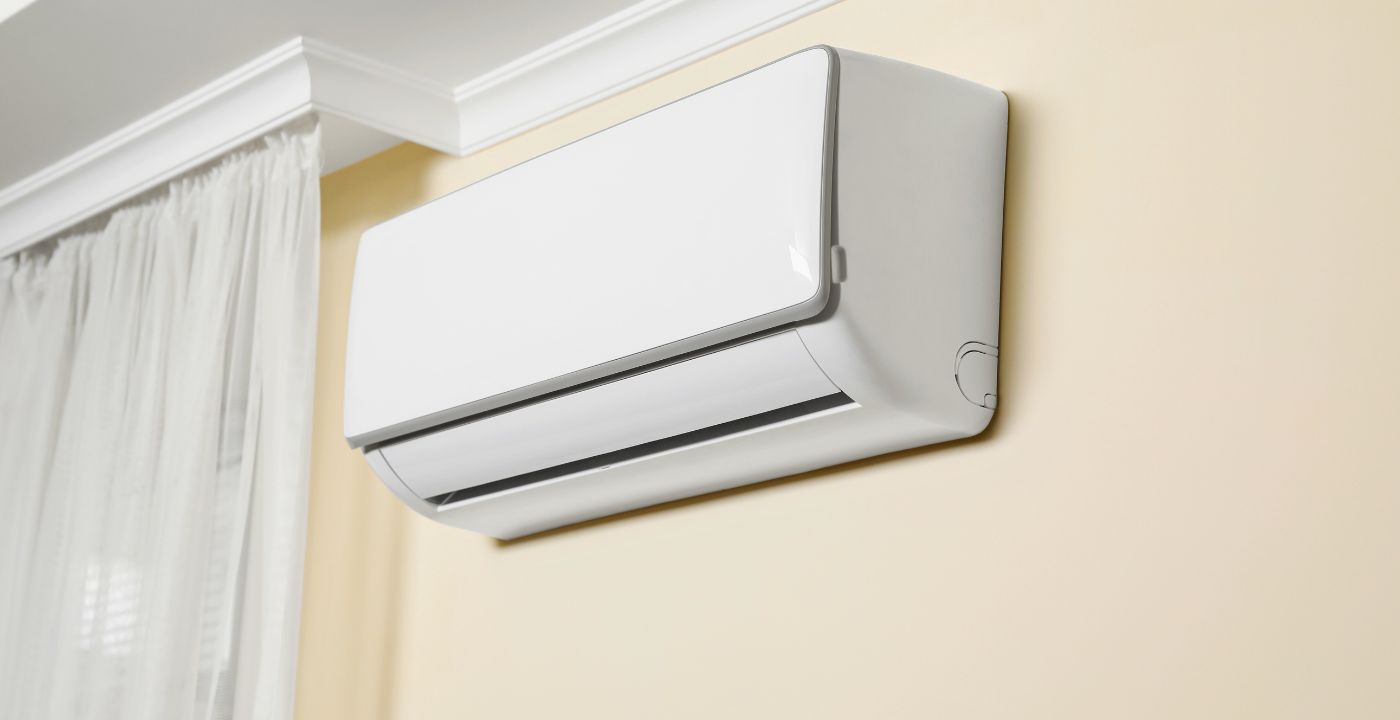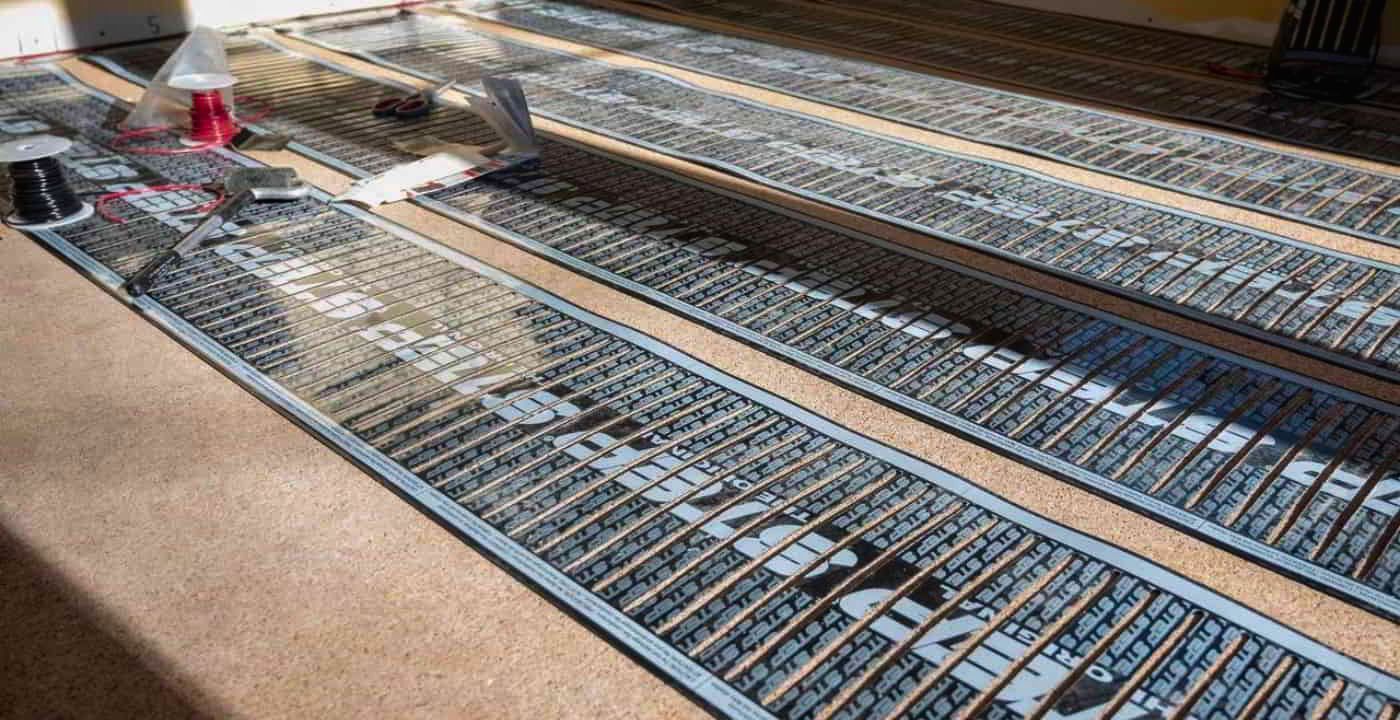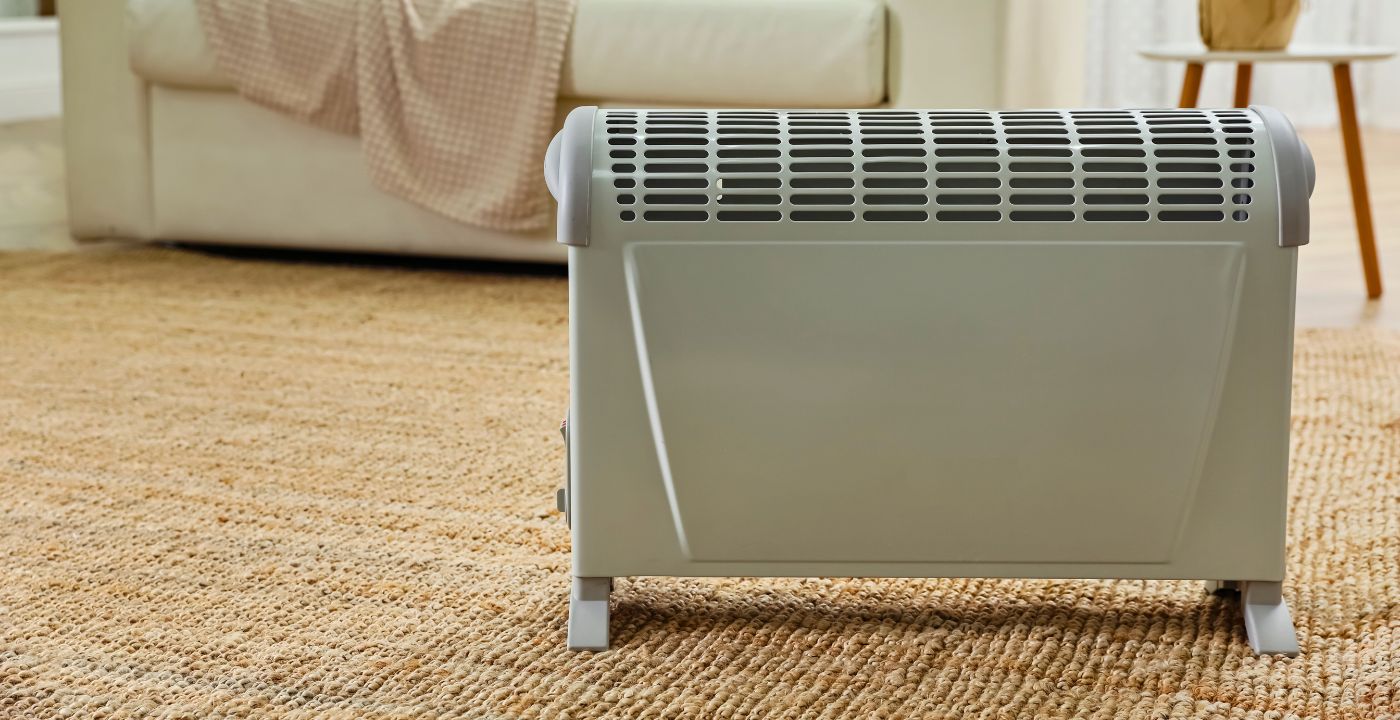Key Notes
- Radiant heating systems (underfloor/panels) offer fully controllable full-room or zonal heating with natural heat ideal for rooms with little or no sunlight like basements.
- Ductless heat pumps offer a great localized heating option that can also provide cooling in the warmer months.
- Wood burning stoves and fireplaces can offer excellent heating options, but their benefits must be weighed against significant health, safety, and environmental risks.
1 - Ductless/Mini-Split Heat Pumps

These systems, comprising an outdoor unit and one or more indoor units, are particularly useful for homes without existing ductwork or for heating specific areas like basements.
Mini-splits are energy efficient, extracting thermal heat from the outside air for heating and functioning in reverse for cooling, which can lead to lower utility bills.
Their design eliminates the energy loss associated with ducted systems and allows for flexible installation, with indoor units that can be mounted on walls or ceilings and outdoor units placed up to 50 feet away.
Furthermore, they improve indoor air quality by avoiding ductwork that can accumulate dust and mold.
Pros
- Energy Efficiency: They are more energy-efficient than traditional systems, saving up to 30% of energy that would be lost in ductwork.
- Flexibility in Installation: Ideal for homes without existing ductwork, new additions, or areas where installing ductwork isn't feasible.
- Dual Functionality: Serve as both heating and cooling systems, reducing the need for separate units.
- Improved Air Quality: Lack of ductwork means less accumulation of dust, debris, and mold.
- Longer Lifespan: Can last 20-30 years with proper maintenance, longer than traditional HVAC systems.
- Individual Zoning: Allows temperature control in different zones or areas independently.
- Remote and Smart Control Options: Many systems offer advanced control features, including synchronization with smartphones for remote operation
Cons
- Higher Initial Installation Cost: May be more expensive to install than traditional systems, especially if ductwork already exists.
- Aesthetic Considerations: Indoor units are more visible than traditional systems and may not blend well with all interior designs.
- Need for Skilled Installation: Proper placement of indoor and outdoor units is crucial for optimal performance.
- Limited Heating in Extreme Cold: While effective in many climates, their efficiency can decrease in extremely cold temperatures.
Rating
Flexible in installation, mini-splits are excellent for zone heating and cooling.
They’re energy-efficient, improving air quality and offering smart control options. However, their higher initial cost and aesthetic considerations might be drawbacks for some users.
2 - Underfloor Radiant Heating

Both electric and hydronic underfloor heating systems distribute heat evenly, ensuring a comfortable living environment without the cold spots common with traditional radiators.
They are unobtrusive, freeing up wall space and improving aesthetics, and have health benefits due to reduced circulation of dust and allergens.
However, the installation process can be invasive and costly, especially in retrofit situations, and the systems are limited to heating with no cooling capabilities.
The choice between electric and hydronic systems often comes down to the specific requirements of the space, budget constraints, and long-term efficiency goals.
Pros
- Even Heat Distribution: Radiant heating provides an even distribution of heat, eliminating cold spots common with radiators.
- Energy Efficiency: Generally, radiant heating systems are more efficient than traditional radiators, requiring lower temperatures to heat a room effectively.
- Health Benefits: These systems don't circulate dust and allergens, making them healthier for indoor air quality.
- Safety and Comfort: Underfloor heating eliminates the need for radiators, reducing risks associated with hot surfaces, and provides a comfortable warmth evenly spread across the floor.
- Aesthetics and Space Saving: The system is invisible and doesn't consume space like traditional radiators, offering more room and design flexibility.
- Low Maintenance: Once installed, underfloor heating systems typically require minimal maintenance.
- Long Lifespan: Can last for 30+ years or longer.
Cons
- High Installation Costs: The initial installation can be expensive, especially if you need a professional installer and when purchasing necessary equipment.
- Retrofitting Challenges: Installing underfloor heating in existing homes can be complex and costly, particularly if it involves altering the current flooring.
- Increased Floor Height: Installation can affect floor height, which might be an issue in homes with lower ceilings.
- Long Installation Time: The installation process can be time-consuming, requiring extensive planning and preparation.
- Limited Cooling Capability: These systems are designed for heating and are not efficient in cooling your home.
- Floor Covering Considerations: Certain types of flooring, like thick carpets, can affect the efficiency of underfloor heating systems.
Rating
Hands down the best way to heat a basement.
You get a warm room, warm feet, and none of the heat from the system is lost to heating the air, which is particularly important in basements that are notoriously drafty and often damp too.
Electric/infrared radiant underfloor heat mats are 30-60% more efficient than line radiant cable/mat systems and traditional hydronic radiant systems.
3 - Adding Registers to Your Existing HVAC/Adding Vents to Existing Ductwork

Adding registers to an existing Forced Air HVAC system or extending vents to existing ductwork can be a great option for people looking for a simpler solution to heating their basement than considering alternative heating systems.
Pros
- Improved Air Distribution: Properly placed registers can enhance airflow and temperature regulation throughout your home. For example, floor registers are beneficial for efficient heating as the warm air naturally rises, heating the room more evenly.
- Customized Comfort: Each room can have its register, allowing for tailored heating or cooling based on the room's specific needs. This can lead to a more comfortable living environment.
- Energy Efficiency: With the right placement and type of registers, you can optimize your HVAC system's energy usage, potentially lowering heating and cooling bills. Ceiling registers, for instance, are ideal for cooling efficiency as cool air falls from these higher points, dispersing more evenly across the room.
Cons
- Installation Complexity: The process of adding registers can be complex, especially in homes where ductwork needs to be extended or modified. This can involve significant labor and potential disruption to your living space.
- Costs: The initial costs of adding registers, including materials and professional installation fees, can be considerable. This is an important factor to consider, particularly if your current system is functioning adequately.
- Aesthetic Impact: Registers, especially wall or ceiling ones, can be more visible and might affect the room's décor or aesthetics. They may also collect dust and require regular cleaning.
- Potential System Strain: If not properly designed and installed, additional registers can strain your HVAC system. For example, if too many vents are added or placed inappropriately, it could disrupt the airflow balance, leading to inefficiencies and increased wear on the system.
- Compatibility Issues: When considering advanced options like smart registers, ensure compatibility with your existing system and thermostat. While smart registers offer zoning and personalized control, they can be more expensive and might not work seamlessly with all systems.
Rating
This is a good option for integrating with an existing system, providing improved air distribution and customized comfort.
However, the installation complexity and potential strain on the existing HVAC system are notable cons, along with the impact on aesthetics and potential compatibility issues with advanced options.
4 - Space Heaters

Space heaters can be a convenient and cost-effective solution for heating small spaces or providing supplemental heat.
However, they are often unsuitable for large areas, can increase electricity bills, and pose safety risks if not used correctly.
Careful consideration and adherence to safety guidelines are essential when using space heaters.
Pros
- Portability and Convenience: Space heaters are small, portable, and easy to move from room to room, providing targeted heating wherever needed.
- Cost-Effective for Small Areas: They are an economical option for heating small spaces compared to central heating systems, which heat the entire home.
- Quick Heating: Space heaters can quickly warm up a room, providing immediate comfort in cold weather.
Cons
- Safety Concerns: Space heaters pose significant fire and burn risks if not used properly. They should never be left unattended and need to be placed away from flammable materials.
- Inefficient for Large Areas: They are not efficient for heating large spaces or entire homes. Their performance can also be dramatically impacted when used in rooms with poor insulation, as is often the case with basements.
- Increased Electricity Bills: Electric space heaters can significantly increase electricity bills, especially when used frequently or for extended periods.
- Limited Heating Capacity: While effective for small areas, space heaters have a limited range and capacity and may not be sufficient in extremely cold conditions.
- Maintenance and Upkeep: Some space heaters, especially gas and oil-filled models, require regular maintenance and proper ventilation to operate safely and efficiently.
Rating
Space heaters are convenient and portable, offering quick heating for small areas.
They’re cost-effective for targeted use but are not suitable for larger spaces and come with some safety concerns. Their inefficiency for large areas and increased electricity bills are major drawbacks.
5 - Radiant Heat Panels

Radiant heat panels, including both wall and ceiling mounted panels, could be a cost-effective alternative to underfloor heating and heat pumps, particularly in smaller spaces like basements.
Here’s a breakdown of their advantages and disadvantages:
Pros
- Zoning Capability: Radiant heating systems allow for easy zoning, enabling control of the temperature in individual rooms or areas. This feature can lead to greater comfort and energy savings.
- Quiet Operation: These systems operate silently, in contrast to forced-air systems that can be noisy.
- Quick Heating: Electric radiant panels can heat up quickly, reaching their programmed temperature in under 20 minutes, providing faster warmth compared to some other heating methods.
- Energy Efficiency: Radiant panels are generally more energy-efficient than forced-air systems as they don't lose heat through ductwork and can operate at lower temperatures while still providing adequate warmth.
- Low Maintenance: These systems have fewer moving parts, reducing the risk of wear and tear. They require minimal maintenance compared to other heating systems like boilers or heat pumps.
- Aesthetic and Space-Saving Design: Radiant panels are compact and can be aesthetically pleasing, often doubling as decorative elements in a room.
Cons
- Uneven Heating: Especially with ceiling panels, there can be a sensation of uneven heating, where the heat is more intense directly below the panel, and cooler at lower levels of the room.
- Operating Costs: Electric radiant panels, while efficient, can increase electricity costs. Proper usage, such as turning off panels when not in use, is important to manage these costs.
Rating
These panels offer a great combination of energy efficiency, aesthetic appeal, and zoning capabilities. Deployed properly they are excellent,they provide quick heating and operate silently.
However, the possibility of uneven heating in larger basements and higher operating costs are potential downsides.
6 - Fireplaces and Stoves

Fireplaces and stoves each have their benefits in terms of warmth and aesthetics, but they also come with considerations such as cost, efficiency, safety, and maintenance. Not to mention health and environmental considerations.
The choice between the two will depend on your specific needs, budget, and the desired aesthetic for your home.
Pros
- Aesthetic Appeal: Fireplaces, in particular, are often seen as aesthetically pleasing and serve as the focal point of a room. They add a traditional and cozy charm to any living space.
- Heat Distribution: Wood stoves are effective in distributing heat in all directions, unlike fireplaces which mainly radiate heat in one direction. This makes wood stoves more efficient in heating a room or space.
- Control Over Fire: Wood stoves provide more control over the fire, as the enclosed environment allows for better regulation of airflow and fuel consumption. This leads to more efficient burning and less firewood usage compared to open fireplaces.
Cons
- Health Concerns: Both fireplaces and wood stoves can impact indoor air quality. They can release particulates, carbon monoxide, and other pollutants, which can be harmful, especially in poorly ventilated spaces. This poses risks to respiratory health, particularly for individuals with existing respiratory conditions or sensitivities.
- Environmental Impact: The burning of wood in fireplaces and stoves contributes to air pollution. It releases particulates and other pollutants that can affect outdoor air quality. Moreover, the efficiency of these heating methods varies, with traditional fireplaces often being less efficient and releasing more pollutants compared to modern, more efficient wood stoves.
- Efficiency: Traditional fireplaces are often less efficient compared to wood stoves. A significant portion of the heat generated in an open fireplace is lost up the chimney, whereas wood stoves retain more heat within the room.
- Fuel Cost: Ongoing costs include the price of firewood, which can vary based on the type of wood and your location. Hardwoods like oak, maple, and birch are preferred for their longer burn time and better heat output.
- Maintenance and Safety Risks: Both fireplaces and stoves require regular maintenance, such as cleaning of soot and creosote buildup, to ensure safe operation. They also pose risks of smoke inhalation and carbon monoxide leaks if not properly maintained.
Rating
While offering aesthetic appeal and effective heat distribution, fireplaces and stoves pose health and environmental concerns.
They are less efficient compared to other options and require regular maintenance. Their traditional charm is balanced by the need for careful use and attention to fuel costs and long term health considerations.
Additional Expert Tips For How To Heat Your Basement
Insulate the basement
Proper insulation is crucial for retaining heat in the basement. This can involve insulating the walls, floors, and ceiling to prevent heat loss and make the space more energy efficient.
Add carpet, or use area rugs and curtains
Adding carpet or area rugs on the floor and heavy curtains on windows can help to trap heat and improve the overall insulation of the basement.
Turn ceiling fans clockwise
In the winter, set ceiling fans to rotate clockwise at a low speed to help circulate warm air trapped near the ceiling back down into the room.
Seal exterior windows
Seal any exterior windows in the basement to prevent heat loss and improve energy efficiency and do the same with gaps or cracks in doors, windows and foundation walls.
Why Should You Choose Underfloor Basement Heating?

Radiant heat mats are considered one of the best ways to heat a basement. These are the top reasons why you should invest in our innovative and sustainable heating technology for your basement:
More Space
Your radiant heat solution is installed below your flooring materials, allowing you to make the most out of your space in the basement.
Supplemental heating technology, such as a space heater or a radiator, will take up valuable space in your basement and dictate how you use the room.
With radiant floor heating, you maximize your flexibility.
No Long Term Maintenance
Radiant heating is an efficient and affordable way to heat a basement. With forced air, you are often paying to distribute warm air to a room with plenty of air leaks, ultimately sending your money out the window.
Radiant heat solutions cost less to operate, and your energy stays inside the room.
Our underfloor heating technology relies on self-regulating carbon polymer heating coils in order to distribute heat to the room.
These elements are thin, flexible, and require little-to-no maintenance over the long term, and they are installed just underneath the flooring materials.
Reliable Heating Solution
With underfloor heating, you can rest easy knowing that your basement will always be heated to your desired temperature.
It is one of the few ways to consistently heat your basement to your preferred temperature
Effective and Sustainable
This technology does more than make the floors warm to the touch — it can serve as a primary or supplemental heat source in the basement.
It’s one of the most effective ways to heat a basement to your desired temperature and maintain it throughout the day.
It is the best basement heating solution because it is effective, efficient, and sustainable.
The Best Materials When Heating Basements with Radiant Flooring
Fortunately, radiant floor heating solutions are compatible with various flooring materials. These are the best floor materials to choose from when heating the basement:
Tile
Tile is one of the most popular flooring materials for underfloor heating because stone tile will heat quickly and retain your desired temperature.
It’s also a good flooring material for basements, which can sometimes flood.

Wood
Natural wood flooring can be used with our radiant floor heating systems, and wood floors are becoming increasingly popular in basements.
It’s important to consider the type of wood that you use, though, as some wood can expand or warp when exposed to heat.

Carpet
Carpet is another viable option with our self-regulating underfloor heating system. You will want to be mindful of the carpet thickness, though, to maximize the efficiency of your system.
Composite Flooring
Composite flooring is an affordable and versatile material compatible with our radiant heat solutions.
FAQs
Are baseboard heaters expensive to operate?
When compared to the main alternatives from traditional HVAC systems to radiant heating solutions baseboard heaters are expensive to run because of their relative energy inefficiency.
Baseboard heaters are roughly twice as expensive to operate as HVAC systems and 75%+ less efficient than radiant heating alternatives.
Can I use a space heater as the primary heating source for my basement?
While space heaters can be used for adding heat to the basement, they are not viable as a total heating solution because they consume a significant amount of electricity.
We strongly recommend you consider more efficient heating options for the primary heating of your basement and reserve the use of space heaters for adding supplemental heat.
Do ductless heat pumps provide cooling as well?
Yes, ductless heat pumps offer both heating and cooling capabilities, making them a versatile solution for year-round temperature control in your basement.
What are the most energy-efficient heating options for basements?
Ductless heat pumps, underfloor radiant heating, and radiant heat panels are the most energy-efficient options for basement heating.
These systems offer efficient heat distribution, lower operating costs, and reduced energy loss compared to traditional heating methods, making them ideal for maintaining a warm and cost-effective basement environment.
Conclusion
To effectively heat a basement, it’s essential to choose a system that optimizes energy efficiency and comfort.
Options like ductless heat pumps, underfloor radiant heating, and radiant heat panels each have distinct advantages.
Pairing these with proper insulation and draft-sealing techniques can significantly boost their efficiency.
If you want to discuss the best radiant heating options for your basement please do get in touch, we’d love to help.





